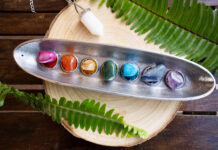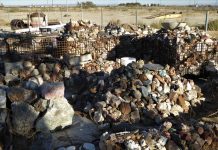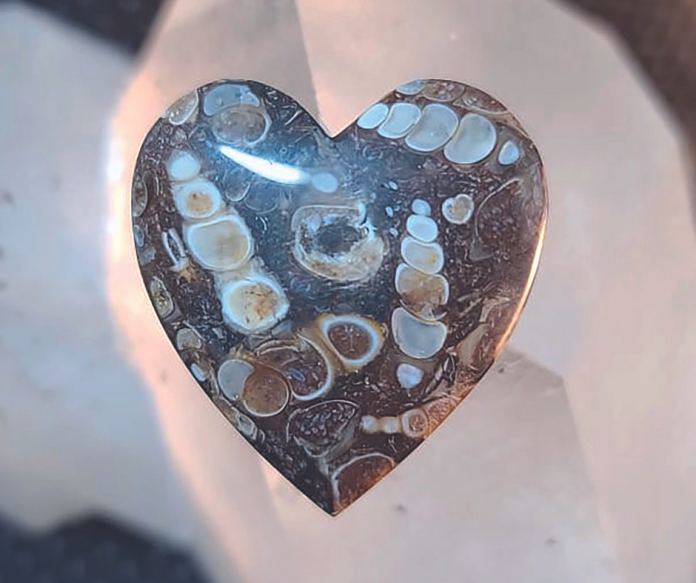
Turritella agate comes from the well-known Green River formation in Wyoming, where many types of fossils are still currently being found. Turritella agate is comprised of an ancient lake bed from over 33 million years ago. The fossil shells are in a grayish brown, to almost a black chalcedony. It’s a favorite to many, as it crosses over from rockhounds to fossil collectors and has been used in lapidary for many decades.
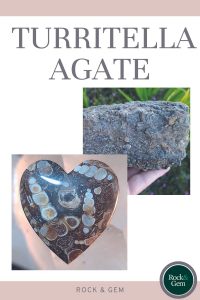
What are agates? Turritella agate has been known as such in the lapidary community for more than 50 years, however, the name is incorrect. Turritella is actually a sea snail. The fossil snails in Turritella agate are the freshwater snails, Elimia tenera. Since this popular name has been carried for so long it seems here to stay.
Finding & Slabbing Turritella Agate
This material can still be found and collected in the wild and is also easily obtained at shows and online sales. If you are making a purchase, it’s best to find the darker-colored matrix. The light gray matrix seems to be far more porous, pitty and crumbly. The darker portions are generally solid and take a far better polish. If you obtain rough material, there is a correct and incorrect way of slabbing it. The rough usually consists of flat seams with shells sticking out of the top and bottom.
To cut this material to get the best visualization of the shells within, you want to cut this material horizontally. If you can imagine a shoebox filled with drinking straws and cut it vertically in half, you will see nothing but a bunch of hollowed circles. This agate is much the same. The best way is to figure out the top portion and start slabbing lengthways, revealing all the cross-sections of the whole shells and not just the middle of them.
Trimming Preforms
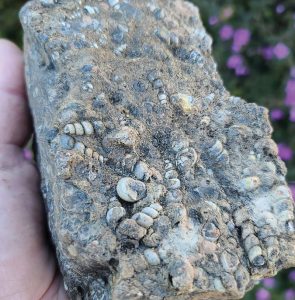 Once you have slabs ready to trim out your preforms, designing with shells can be a lot of fun. Remember that these shells are generally not very big around. You may lose some of the patterns you are looking at in the slab once you start to grind your cab, so it’s best to start with the largest shells. One thing you will notice when cabbing this material is, it has a crude oil smell, because of its fossiliferous material, and it’s always best to wear at least an N95 mask while grinding this material.
Once you have slabs ready to trim out your preforms, designing with shells can be a lot of fun. Remember that these shells are generally not very big around. You may lose some of the patterns you are looking at in the slab once you start to grind your cab, so it’s best to start with the largest shells. One thing you will notice when cabbing this material is, it has a crude oil smell, because of its fossiliferous material, and it’s always best to wear at least an N95 mask while grinding this material.
Cabbing Turritella Agate
The cabbing process is fairly easy, I start with a steel 80 grit wheel to shape and dome my preform cabs, then move on to the sanding wheels. Whether you use a 140 soft resin wheel, or a 220, either will smooth out the cab and take out the majority of the scratches. From this point, move on to the 280 soft resin grit wheel, and be sure that you go no further until all the scratches are eliminated.
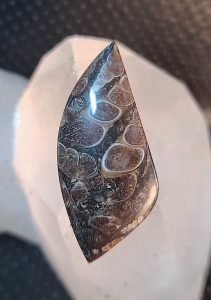 Depending on how silicated your material is, you may already start to see a nice polish developing. Other times you may have some porous areas that might not polish quite as well leaving some dull spots. This is fairly common. Continue to the 600 and 1200 and from here you will see the polish start to shine. I generally move up to the 8k grit and finish on a 14k soft resin grit wheel. This will leave you with a beautifully polished cab.
Depending on how silicated your material is, you may already start to see a nice polish developing. Other times you may have some porous areas that might not polish quite as well leaving some dull spots. This is fairly common. Continue to the 600 and 1200 and from here you will see the polish start to shine. I generally move up to the 8k grit and finish on a 14k soft resin grit wheel. This will leave you with a beautifully polished cab.
You can use a bit of Zam polishing compound on a felt polishing tip with your Dremel to obtain a higher polish if you wish. You will have a gorgeous piece of history embedded in your jewelry piece.
This What to Cut column about Turritella agate previously appeared in Rock & Gem magazine. Click here to subscribe. Story by Russ Kaniuth.


